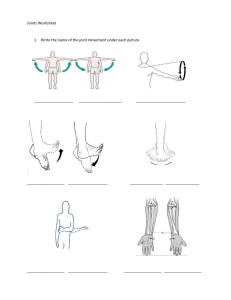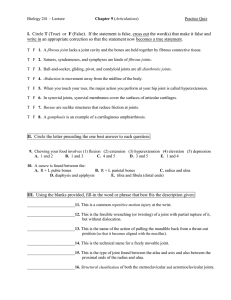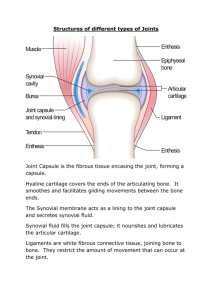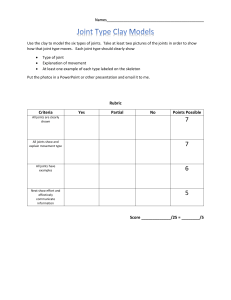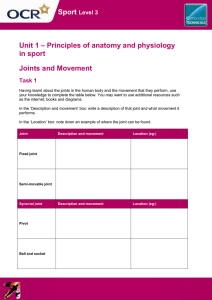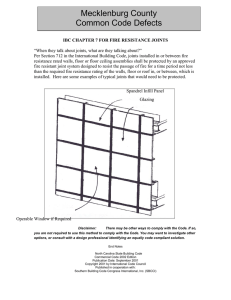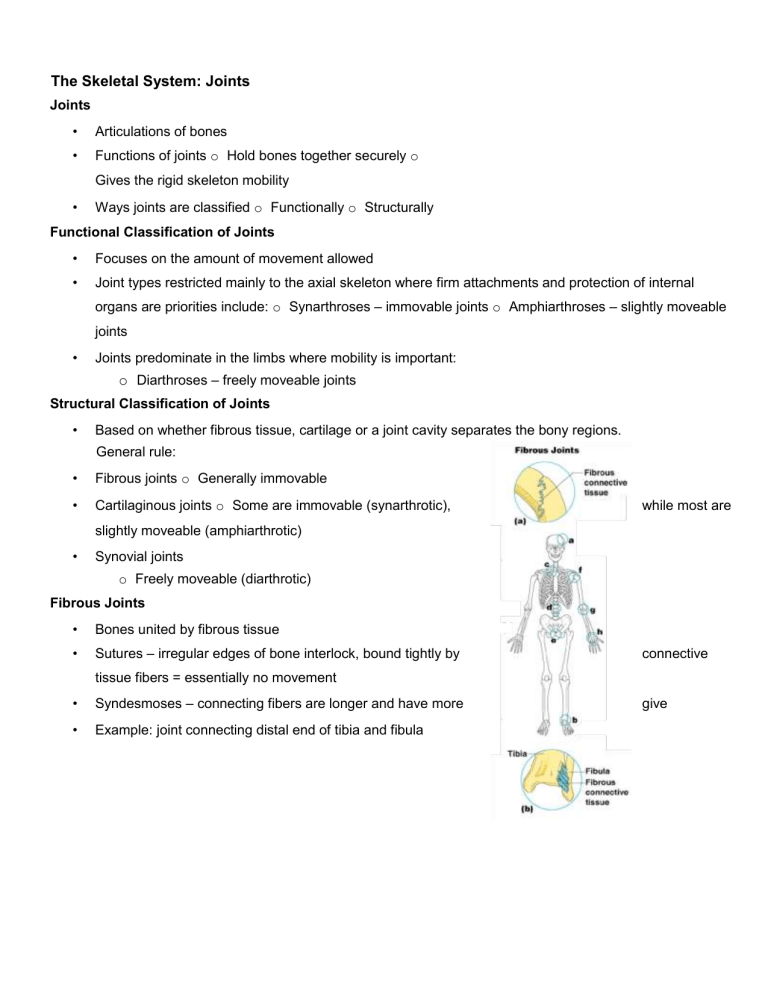
The Skeletal System: Joints Joints • Articulations of bones • Functions of joints o Hold bones together securely o Gives the rigid skeleton mobility • Ways joints are classified o Functionally o Structurally Functional Classification of Joints • Focuses on the amount of movement allowed • Joint types restricted mainly to the axial skeleton where firm attachments and protection of internal organs are priorities include: o Synarthroses – immovable joints o Amphiarthroses – slightly moveable joints • Joints predominate in the limbs where mobility is important: o Diarthroses – freely moveable joints Structural Classification of Joints • Based on whether fibrous tissue, cartilage or a joint cavity separates the bony regions. General rule: • Fibrous joints o Generally immovable • Cartilaginous joints o Some are immovable (synarthrotic), while most are slightly moveable (amphiarthrotic) • Synovial joints o Freely moveable (diarthrotic) Fibrous Joints • Bones united by fibrous tissue • Sutures – irregular edges of bone interlock, bound tightly by connective tissue fibers = essentially no movement • Syndesmoses – connecting fibers are longer and have more • Example: joint connecting distal end of tibia and fibula give Cartilaginous Joints • Bones ends connected by cartilage • Slightly moveable (amphiarthrotic) o Pubic symphysis o Intervertebral joints • Immovable (synarthrotic) o Hyaline-cartilage epiphyseal plates of growing long bones o Cartilaginous joints between the 1 st ribs and the sternum Synovial Joints • • Articulating bones are separated by a joint cavity Synovial fluid is found in the joint cavity • All joints of the limbs Features of Synovial Joints • Articular cartilage (hyaline cartilage) covers the ends of bones forming the joint • A fibrous articular capsule lined with a smooth synovial membrane encloses joint surfaces • Have a joint cavity filled with lubricating synovial fluid • Ligaments surround the capsule and reinforce the joint Structures Associated with the Synovial Joint • Bursae – flattened fibrous sacs • Lined with synovial membranes • Filled with synovial fluid • Not actually part of the joint – act like ball bearings to reduce friction • Common where ligaments, muscles, skin, tendons or bones rub together The Synovial Joint • Tendon Sheath o Elongated bursa that wraps completely around a tendon that is subjected to friction Types of Synovial Joints Based on Shape • The shapes of the articulating bone surfaces determine the movement of a joint. o Plane joint Articular surfaces are essentially flat & only short, gliding movements are allowed. Nonaxial = no rotation. Ex: intercarpal joints of wrist. o Hinge joint Cylindrical end of 1 bone fits into a trough-shaped surface of another bone. Angular movement in one plane. Uniaxial = allow movement around one axis only. Ex: elbow, ankle, & joints between phalanges. o Pivot joint Rounded end of 1 bone fits into a sleeve or ring of bone (& possibly ligaments). Uniaxial – can only turn around its long axis. Ex: proximal radioulnar joint & joint between the atlas & the dens of the axis. o Condyloid joint/ A.K.A Ellipsoid joint (knuckle-like) Egg-shaped articular surface of 1 bone fits into the oval concavity of another. Both surfaces are oval. Allows the moving bone to travel from side to side & back and forth, but can’t rotate around its long axis. Biaxial (movement around 2 axes) Ex: metacarpophalangeal joints (knuckles). o Saddle joint Each articular surface has both convex & concave areas, like a saddle Biaxial like the condyloid joints Ex: carpometacarpal joints in the thumb (twiddling!) o Ball & Socket joint Spherical head of one bone fits into round socket in another Multiaxial joint (mov’t in all axes including rotation) The most freely moving synovial joint Ex: shoulder & hip Inflammatory Conditions Associated with Joints • Bursitis – inflammation of a bursa usually caused by a blow or friction • Tendonitis – inflammation of tendon sheaths • Arthritis – inflammatory or degenerative diseases of joints o Over 100 different types o The most widespread crippling disease in the United States Clinical Forms of Arthritis • Osteoarthritis o Most common chronic arthritis o Probably related to normal aging processes • Rheumatoid arthritis o An autoimmune disease – the immune system attacks the joints o Symptoms begin with bilateral inflammation of certain joints o Often leads to deformities • Gouty Arthritis o Inflammation of joints is caused by a deposition of urate crystals from the blood o Can usually be controlled with diet Body Movements • Flexion o The process of bending or the state of being bent. • Extension o The act of straightening or extending a flexed limb Hyperextension o Flexion of a limb or part beyond its normal range o • Rotation o • The process of turning around an axis. Abduction o To draw away from the median plane, or (the digits) from the axial line of a limb • Adduction o To draw toward the median plane or (in the digits) toward the axial line of a limb • Circumduction o Movement of a part in a circular direction • • Dorsiflexion o The turning of the foot or the toes upward • Plantar flexion o Extension of the ankle resulting in the forefoot moving away from the body • Inversion o Turning inward • Eversion o • Turning outward Supination o Applied to the hand, the act of turning the palm forward (anteriorly) or upward, performed by lateral rotation of the forearm o Applied to the foot, it generally implies movements resulting in raising of the medial margin of the foot, hence of the longitudinal arch • Pronation o Applied to the hand, the act of turning the palm backward (posteriorly) or downward, performed by medial rotation of the forearm. o Applied to the foot, a combination of eversion and abduction movements taking place in the tarsal and metatarsal joints and resulting in lowering of the medial margin of the foot, hence of the longitudinal arch Opposition o The thumb, unlike other fingers, is opposable, in that it is the only digit on the human hand which is able to oppose or turn back against the other four fingers, and thus enables the hand to refine its grip to hold objects which it would be unable to do otherwise TYPES OF MUSCLE FIBERS: SC: IWBAT compare between Slow Twitch and Fast Twitch Muscle Fibers •

